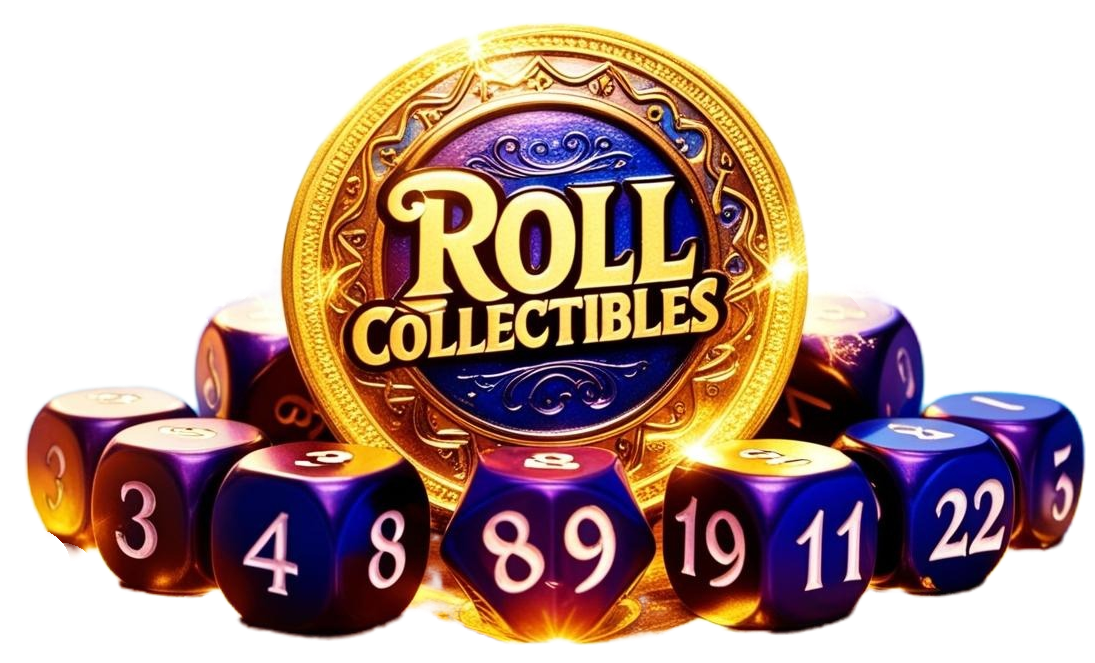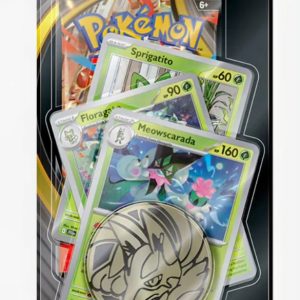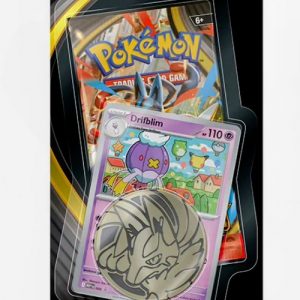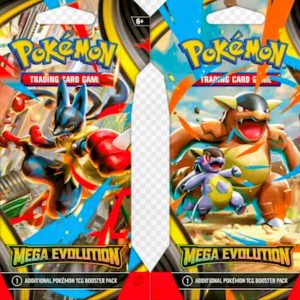Read the Card Directions:
Read all the text on the card, checking for spelling and grammar mistakes. Mistakes like these nearly always indicate the card is fake.
Red flags:
Spelling errors.
Grammatical errors.
Any instance of the word “Pokémon” without an accent over the e.
Any term for Pokémon other than “Pokémon,” such as “Pocket Monster.”
HP or Attack values of 1000 or more. (As of 2023, no Pokémon card has an HP higher than 340.)
Fake Pokémon card: Jolteon with spelling mistakes
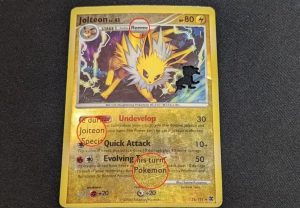
Fake Pokémon card: Charizard printed as Caterpie

Compare the Card Back Directions:
Compare the card’s back to the back of a card that is known to be authentic. If both cards are authentic, their backs should be nearly identical.
Red flags:
Bleeding between the blue border and the blue in the rest of the card’s design. The border on the back of real Pokémon cards is quite distinct, and different from the other blues in the design.
Washed out colors.
Fake and real Pokémon cards backs 1
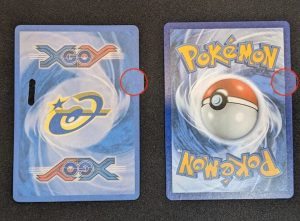
No Pokémon card in English or any other languages have a design like the left card, this is a sure way to tell if a card is fake.
Fake and real Pokémon cards backs 2

Look for the centering of a card, the left is so far out, the board is nearly none existent, also the colour bleeding is also really bad.
Fake and real Pokémon cards backs 3

Look at the colours, the left hand card is dull with no texture and the colours are not sharp and bold.
Compare the Card to an Online Scan
Directions:
Pull up an image of the card online using a reputable Pokémon TCG database like the the official Trading Card Database or pkmncards.com. Compare your card to the picture and look for any inconsistencies.
Red flags:
Wrong font, or font size.
Wrong energy symbols, or energy symbols the wrong size.
Wrong HP value.
Wrong attack damage values.
Wrong weakness, resistance, or retreat cost.
Wrong set symbol or set number.
Foiling when the card shouldn’t be foil, and vice versa.
Fake and real Pokémon cards: Jirachi
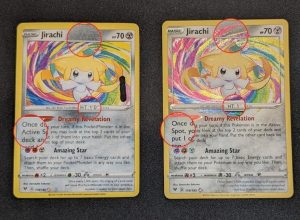
Fake and real Pokémon cards: Tag Team Gardevoir & Sylveon
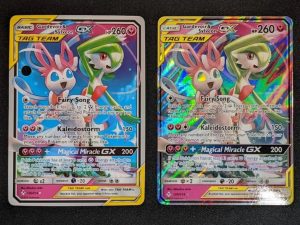
Cards from the tag team era are a lot harder to tell if they are fake or not, just pay close attention to how the card should look, do this by going online, there you will find out that the card should be a holo foil card with a shine, not like the one on the left side.
Compare the Card to an Authentic Pokémon Card
Directions:
Compare the suspicious card to a card you know to be authentic. Ideally you’ll use another copy of the exact same card, but that’s not always possible. You want a card with as many similarities as possible—same set, same rarity, same kind of foiling, etc. Compare the two cards and look for minute differences.
Red flags:
All the red flags from Test #3.
Excessive weight difference.
Cardstock is too thin.
Cardstock is too weak.
Flat, untextured foiling when the foiling style should leave a texture.
Messy edges. The edges of a real Pokémon card are straight and clean, without any cardboard residue.
Fake and real Pokémon cards: Ultra Ball
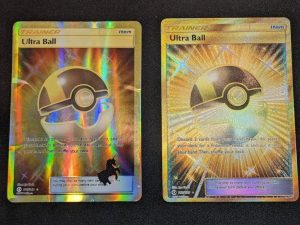
the texture here is all off because there isn’t any on the left card, its flat and the next biggest give away is the rainbow shine, 99.9 of Pokémon cards the rainbow shine goes across the card in a diagonal direction. if you look at the fake on the left this pattern goes vertical.
How to Spot Fake Sealed Pokémon Products:
Counterfeit sealed products are unfortunately common in the Pokémon world. Much like fake cards, scammers mostly produce poor imitation products to scam kids and parents, although more “savvy” buyers aren’t immune. Last year, a speculator associated with Logan Paul attempted to sell a box of 1st Edition Base Set, only to learn that the packs inside didn’t match the box. Somebody had already opened the box, filled it with other cards, and resealed it.
These types of scams make it very hard to tell that a sealed product is fake or tampered with before you’ve opened it—at which point it’s probably too late. Still, a few best practices go a long way to helping you avoid wasting hundreds of dollars on counterfeit Pokémon cards.
First.
Buy Smart:
Whenever you buy sealed Pokémon cards, exercise a healthy amount of caution. If a deal looks too good to be true, it probably is. You should be skeptical whenever you see a sealed Pokémon product going for much less than its listed price on the official Pokémon Center store.
Don’t buy boxes or packs from unknown or unreliable sources. Flea markets are lousy with counterfeit Pokémon products of varying quality. Online marketplaces like Craigslist, Facebook, Amazon, and eBay can be tricky. We’re obviously biased, but we think TCGplayer is the safest way to get authentic cards for the best price. Whatever platform you decide to use, make sure they have strong policies that protect you from fraud.
Second, Read Before You Buy
Whenever possible, before you buy a sealed Pokémon product, read the text on the package and check the images and logos.
Red flags:
Spelling mistakes.
Grammar mistakes.
References to Pokémon sets besides the one the product is from.
Any images from the Pokémon anime. Pokémon card products always use original art.
Real Pokémon booster boxes are always wrapped in soft cellophane with a Poké Ball logo. If the cellophane is hard and crackly or doesn’t have the Poké Ball logo, that’s a bad sign. It may have been opened and resealed, or the entire box could be counterfeit.
Real Pokémon booster packs have straight, flat edges along their seals, and hardly any air around the cards inside.
Fake and real Pokémon booster packs
If you ever see a Pokémon pack with serrated edging like a triangle pattern then this pack will be fake, the best thing to do is walk away. if you come across this in a shop within the uk you can report them to trading standards.
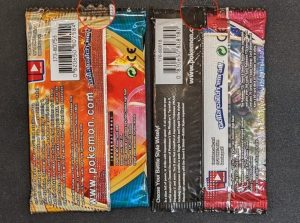
If the edge of a booster pack is ribbed or wavy, or the cards have too much room in the pack, that’s another sign the contents are fake.
If you do open a pack of fake Pokémon cards, a few signs can immediately indicate that the cards you’re looking at aren’t real.
Contents of a fake Pokémon booster pack.
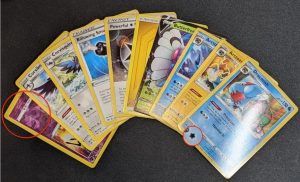
The number of rare cards in a real booster pack can vary depending on the set and other factors. That said, if you’re opening a booster pack from a normal set and the first card is a rare, you should probably take a closer look.
The cards in a real booster pack are always packed with the same orientation (facing the same direction, same side up). If a pack contains tons of rares and the cards aren’t oriented the same way, it’s almost certainly fake.
